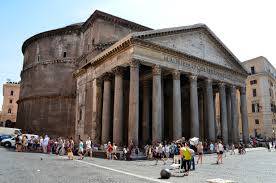When we think of ancient Rome, images of grandiose
architecture like the Colosseum and the Pantheon often come to mind. These
iconic structures have endured for over two millennia, and while their
impressive designs and engineering marvels certainly contribute to their
longevity, there's another key factor at play: Roman concrete.
You might be surprised to learn that this ancient material
is actually more durable than many of the concretes we use today. Roman
concrete, known as "opus caementicium," was made from a mixture of
volcanic ash, lime (calcium oxide), and seawater. The results? Structures that
have not only withstood the test of time but have also demonstrated remarkable
resilience against environmental conditions.
The Secret Ingredient: Volcanic Ash
One of the most fascinating aspects of Roman concrete is its
use of volcanic ash. This ash, sourced from various volcanic regions around the
Mediterranean, played a crucial role in the material’s durability. When
combined with lime and seawater, the ash helped create a chemical reaction that
actually strengthened the concrete over time. This process, known as pozzolanic
reaction, forms a substance called calcium-aluminum-silicate-hydrate (CASH)
which is incredibly stable and resistant to weathering.
The Seawater Advantage
Roman engineers were particularly adept at utilizing
seawater in their concrete mix. Unlike modern concrete, which often
deteriorates when exposed to saltwater, Roman concrete appears to improve when
submerged. The interaction between the seawater and the volcanic ash results in
a crystalline structure that further enhances the material’s strength and
resistance to cracking. This is one reason why many Roman marine structures,
such as harbors and breakwaters, have survived intact for centuries.
The Pantheon and Colosseum: Concrete Marvels
The Pantheon and the Colosseum are perhaps the most famous
examples of Roman concrete’s enduring legacy. The Pantheon’s dome, with its
enormous span and oculus, was made possible by the use of lightweight concrete
that was mixed with pumice, a volcanic rock. This allowed the dome to be both
massive and surprisingly lightweight. The Colosseum, built using a combination
of concrete and stone, has managed to stand strong through countless natural
disasters and centuries of wear and tear.
Lessons for Modern Construction
The durability of Roman concrete has not gone unnoticed by
modern engineers and scientists. Researchers are studying the ancient material
to uncover its secrets and potentially improve contemporary concrete
technologies. Understanding the chemistry behind Roman concrete could lead to
the development of more sustainable and long-lasting building materials for the
future.
In summary, the incredible longevity of Roman concrete is a
testament to the ingenuity and skill of ancient Roman engineers. Their use of
volcanic ash and seawater created a material that has not only stood the test
of time but continues to inspire modern construction practices. So next time
you marvel at a Roman ruin, remember that you’re looking at a concrete
masterpiece that has defied the ages.


